未知
Xenia is the preferred food of Phyllodesmium crypticum.
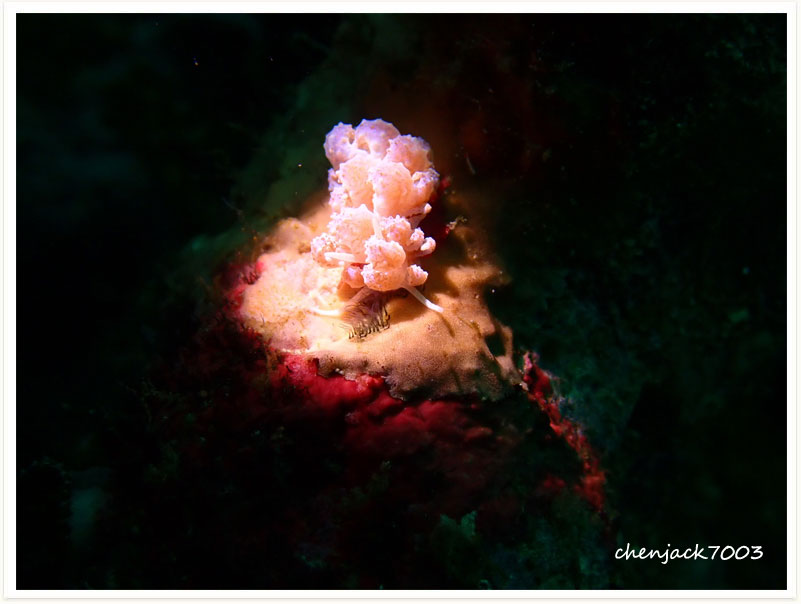
 Underwater Photography
Underwater PhotographyXenia is the preferred food of Phyllodesmium crypticum.

Although this nudibranch changes appearance as it grows, three median clusters of (usually) pink tubercles remain the same, except that they are amalgamated in juveniles and separated in large animals. These tubercles can range in color from pink to green to white. The intensity of the pink coloration and green-grey tones may possibly be related to diet, and the length of time since last feeding. Other distinguishing features are the pale pink edge of the mantle, the broad, triangular, black tipped oral tentacles and the rhinophoral clavus possessing 22 to 26 lamellae (in specimens greater than 35 mm).
The body is pink with a network of broad black lines and opaque white tubercles.
Paradoris liturata mimic perfectly phyllidiid sea slugs Phyllidiella pustulosa).It is difficulty to identifiy as Paradoris liturata,its only for experts.Paradoris liturata can retract its gills to mimic to P. pustulosa.
This nudibranch was described from a specimen measuring 70 mm (2.8 in) in length, dredged in 110 m (360 ft) at Recruit Island, Senkaku Islands, 150 miles NE of Taiwan, 25.922745°N 124.558247°E. It is currently identified with an animal which is widespread in shallow water in the central Indo-Pacific region. Many records are incorrect as it has now been shown that at least eight species have been confused under this name in the past. The H. bullockii clade contains seven species, plus H. iba is a mimic of H. bullocki. Six of these can be found in the Philippines. Hypselodoris apolegma is found throughout the western Pacific from Japan (Okinawa), the Philippines, Indonesia Malaysia (Sabah) whereas H. brycei, is found only in Western Australia (Houtman Abrolhos Islands to the Exmouth Region and Dampier Archipelago). Hypselodoris bullockii is considered to be widespread in the western and central Pacific, from Japan, Taiwan, Hong Kong, the Philippines, Indonesia, Malaysia, eastern Australia, the Marshall Islands and New Caledonia, whereas H. melanesica is known only from Papua New Guinea and the Solomon Islands, both of which are areas where H. bullockii is absent. Hypselodoris rositoi is apparently restricted to the northern Philippines and H. violacea is apparently restricted to Sabah, Malaysia and Palawan Island, Philippines. Hypselodoris variobranchia is apparently restricted to Japan (Okinawa), Taiwan, the Philippines, Malaysia, Indonesia and Queensland, Australia.
Hypselodoris apolegma (formerly classified as Risbecia apolegema)feeds on sponges (mainly genus Euryspongia)
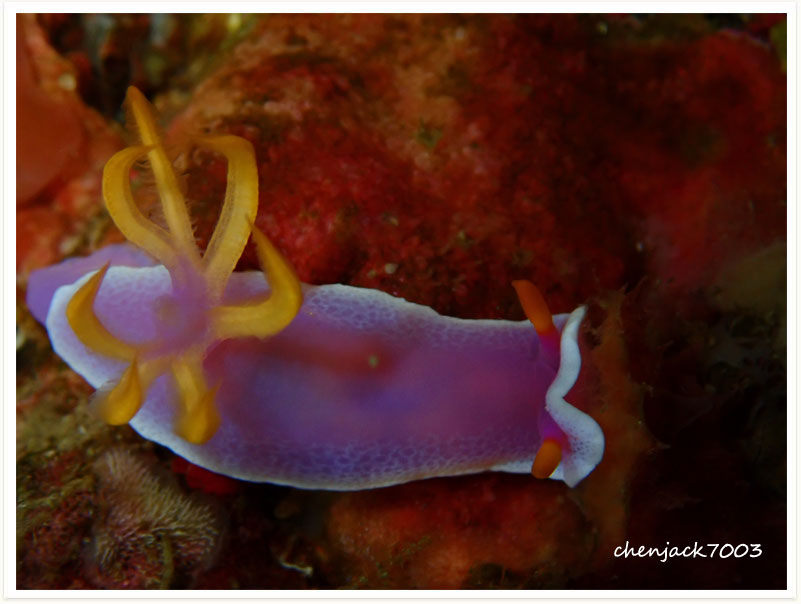
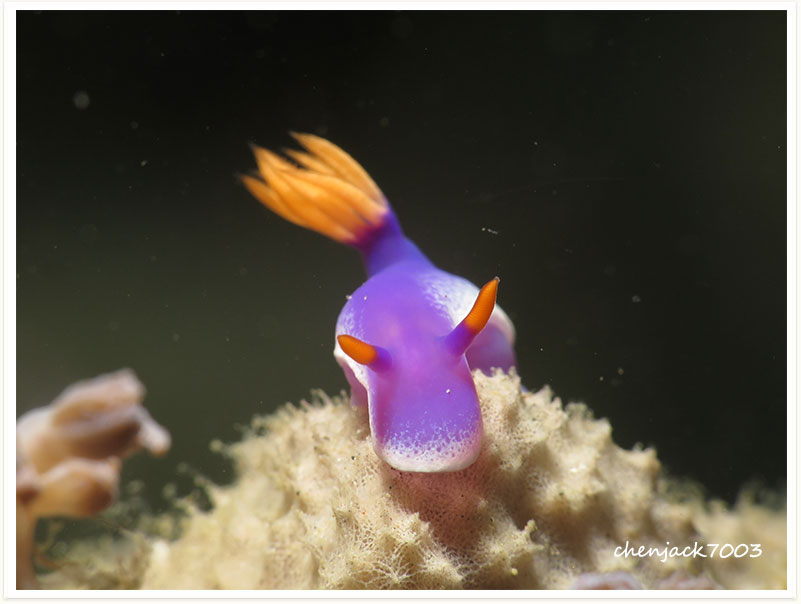

Batangas Halgerda is white with orange markings, has a network of fine red-orange lines on the body and orange-red tiped tubercles.This nudibranch lives in the tropical western Pacific.Halgerda species only feed on sponges.
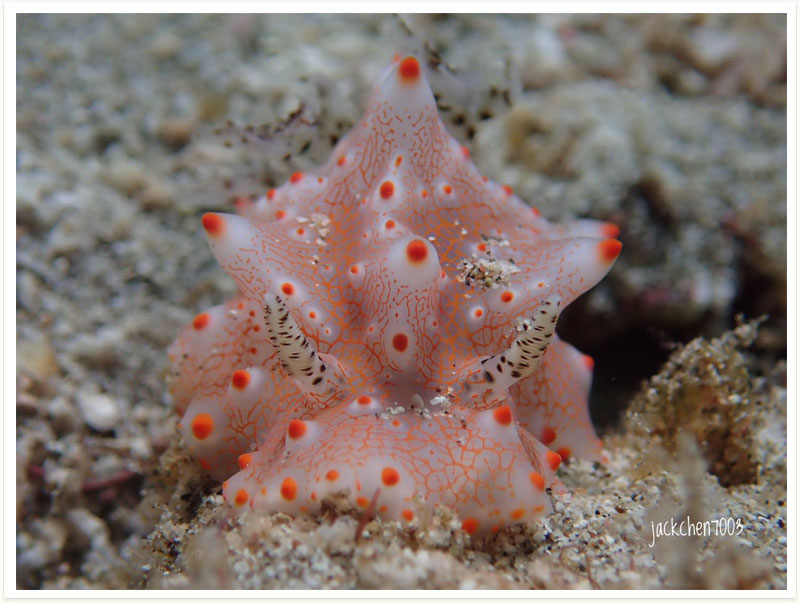
The original description included the following colour information: “Colour cream white, passing into cream yellow towards the margins, which are ornamented with a series of oblong violet spots. The central portion of the mantle is studded with numerous slightly elevated orange dots. Branchiae colourless, tentacles chocolate brown, laminae white. Under surface colourless, with the exception of a light tinge of the dorsal colours, which are transmitted through the pellucid mantle.”
Quite similar in appearance to C. geometrica. Two major points of difference are the rhinophore & gill colour and the presence of a few small white rounded nodules on the mantle, each surrounded by a ring of deep magenta (or purple). The gills and rhinophores are a translucent reddish purple colour edged with a dark line of the same colour. Like C. geometrica the anterior mantle waves up and down rhythmically and its underside is a deep purplish colour.
The mantle is margined in yellow, dark blue and light blue, somtimes the dark and light blue are reversed. The foot is bright yellow or yellow-orange.The egg mass is peach-colored ribbon.
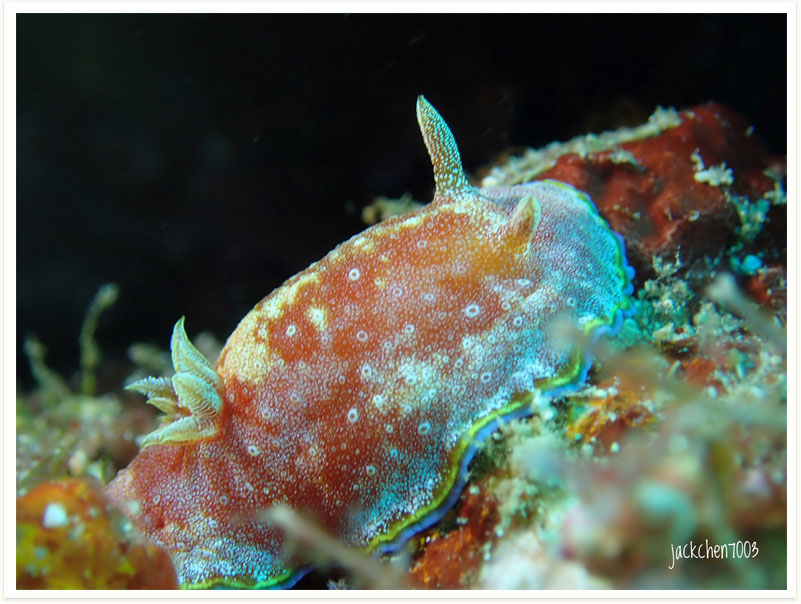
A new described species
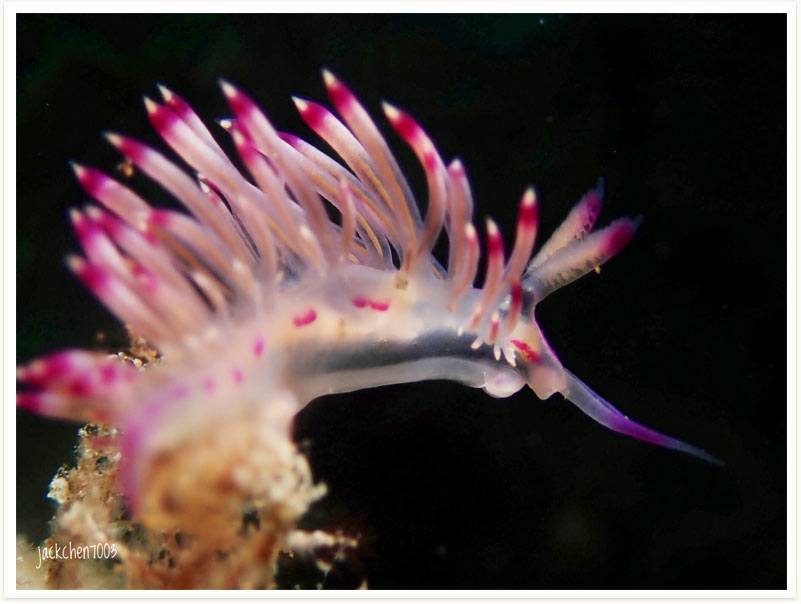
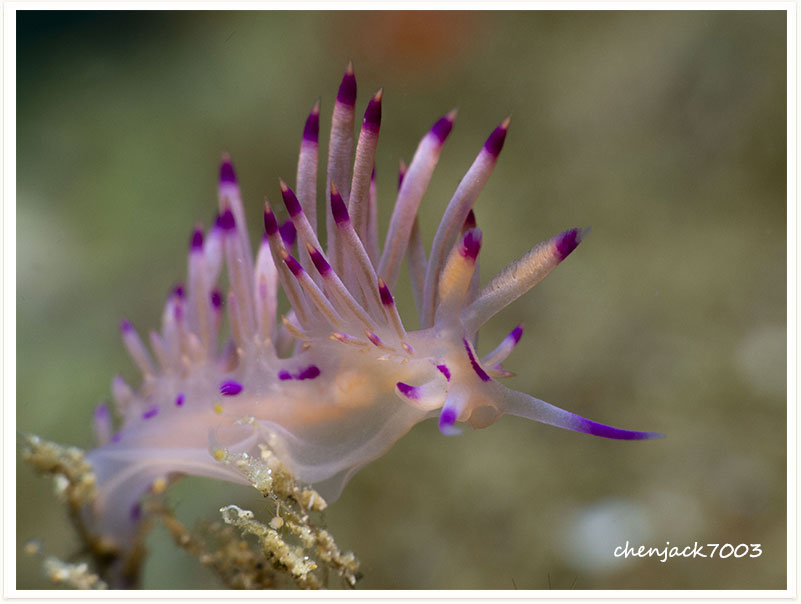
Ceratosoma trilobatum can grow to a maximal size of 15 cm length. The body colouration is extremely variable but is always composed of bright colors. However, the body colouration is not a valuable criterion of determination for this species because it can easily be confused with Ceratosoma tenue.
Feed on barnacles, sea squirts, soft corals, and /or sponges sponge (f.e. Halisarca metabola de Laubenfels, 1954).
Cadlinella ornatissima is a widespread and common species, occurring in tropic and sometimes in sub tropical zones.Its body is mostly yellow to orange, sometimes white and filled with many thick and elongated warts.The warts have usually a pink to reddish tip, are their gills and the rhinophores white-transparent. Best left in the wild.
This sea hare is distributed in Indo-West Pacific.Aplysia oculifera have small brown eye-spots all over the head and the parapodia.The spotted sea hare often seen on sandy sheltered shores among seagrasses, but also can be found to dephts of 10 m.If they feel disturbed,they able to squirt a red ink.
Sebastapistes strongia, the barchin scorpionfish, is a scorpionfish from the Indo-Pacific.The species is commonly seen in areas with mixed sand and rubble in reef flats, shallow lagoons, and channels. The species is nocturnal and can grow to a maximum length of 60 mm (2.4 in)
The red lionfish (Pterois volitans) is a venomouscoral reef fish in the familyScorpaenidae, orderScorpaeniformes. P. volitans is native to the Indo-Pacific region, but has become an invasive species in the Caribbean Sea, as well as along the East Coast of the United States and East Mediterranean. This and a similar species, Pterois miles, have both been deemed invasive species. Red lionfish are clad in white stripes alternated with red/maroon/brown stripes. Adults in this species can grow as large as 47 cm (18.5 in) in length, making it one of the largest species of lionfish in the ocean, while juveniles are typically shorter than 1 inch (2.5 cm). The average red lionfish lives around 10 years. As with many species within the family Scopaenidae, it has large, venomous spines that protrude from the body, similar to a mane, giving it the common name lionfish. The venomous spines make the fish inedible or deter most potential predators. Lionfish reproduce monthly and are able to quickly disperse during their larval stage for expansion of their invasive region. No definitive predators of the lionfish are known, and many organizations are promoting the harvest and consumption of lionfish in efforts to prevent further increases in the already high population densities.
This fish is coppery-coloured with a broad blackish bar at the base of the tail, up to 14.5 cm in length. The upper jaw has a narrow blue streak, and a broad blackish stripe extends from the front of the snout to the eye. Easily confused with Ostorhinchus fleurieu, where the black tail bar does not narrow in the centre, but unlike this species, the stripe is also present in juveniles.
The diameter when fully grown is slightly greater than the height of an average man. The species was named in tribute to Mr. Kan’ichi Nomura (C18–C19), Director General of the Fukui Prefectural Fisheries Experimental Station, who in early December 1921 sent a specimen in a 72-litre wooden tank to Professor Kishinouye, who found that it was unknown and spent some time at the station to study living specimens.
M. pfefferi is a robust-looking species, having a very broad, oval mantle. Arms are broad and blade-like and have four rows of suckers. The modified arm used by males for fertilisation, called the hectocotylus, is borne on the left ventral arm. The oral surface of the modified region of the hectocotylus is wide, swollen, and fleshy. It bears transversely grooved ridges and a deep furrow running along the middle. The sucker-bearing surface of the tentacular clubs is flattened, with 5 or 6 suckers arranged in transverse rows. These suckers differ greatly in size, with the largest located near the centre of the club. Three to four median suckers are especially large, occupying most of middle portion of the club. The swimming keel of the club extends considerably near to the carpus. The dorsal and ventral protective membranes are not joined at the base of the club, but fused to the tentacular stalk. Dorsal and ventral membranes differ in length and extend near to the carpus along the stalk. The dorsal membrane forms a shallow cleft at the junction with the stalk. This particular species of cuttlefish is the only one known to walk upon the sea floor. Due to the small size of its cuttlebone, it can float only for a short time.
The pygmy seahorse is well camouflaged and extremely difficult to spot amongst the gorgonian coral it inhabits. So effective is this camouflage that the species wasn’t actually discovered until its host gorgonian was being examined in a laboratory.In 1969, a New Caledonian scientist, Georges Bargibant, was collecting specimens of Muricella gorgonians for the Nouméa museum and whilst one of these was on his dissection table he happened to notice a pair of tiny seahorses. The next year they were officially named by Whitley as “Bargibant’s pygmy seahorse.” Large, bulbous tubercles cover its body and match the colour and shape of the polyps of its host species of gorgonian coral, while its body matches the gorgonian stem. It is not known whether individuals can change colour if they change hosts, although the ability to change colour according to their surroundings does exist in some other seahorse species, such as Hippocampus whitei. Other distinctive pygmy seahorse characteristics include a fleshy head and body, a very short snout, and a long, prehensile tail. This is also one of the smallest seahorse species in the world, typically measuring less than 2 centimetres (0.79 in) in height.
The spotted hawkfish, Cirrhitichthys aprinus is a species of hawkfish widespread throughout the tropical waters of the Indo-West Pacific region.A common species, it is found in rocky and coral areas of subtidal coastal reefs.
It can reach a maximum length of 12.5 cm (4.9 in). It is a food fish for indigenous peoples and can also be found in the aquarium trade. It is red-pink and white in color, and has tassels on the tip of its dorsal fin.
Aurelia aurita (also called the common jellyfish, moon jellyfish, moon jelly or saucer jelly) is a widely studied species of the genus Aurelia. All species in the genus are closely related, and it is difficult to identify Aurelia medusae without genetic sampling; most of what follows applies equally to all species of the genus. The most common method used to identify the species consists of selecting a jellyfish from a harbour using a device, usually a drinking glass and then photographing the subject. This means that they can be released in to the harbour shortly afterwards and return to their natural habitat.
The body of A. perideraion is pink to peach. It has the white stripe along the dorsal ridge that is common to all members of the skunk complex and a white head bar running vertically just behind the eye. While the largest species of anemonefish can reach a length of 18 cm (7.1 in), A. perideraion is one of the smallest species, with females growing to a length of 10 cm (3.9 in).
Lissoporcellana nakasonei is a ten-pot species from the Porcellanidae family. The scientific name of the species was first validly published in 1978 by Miyake.
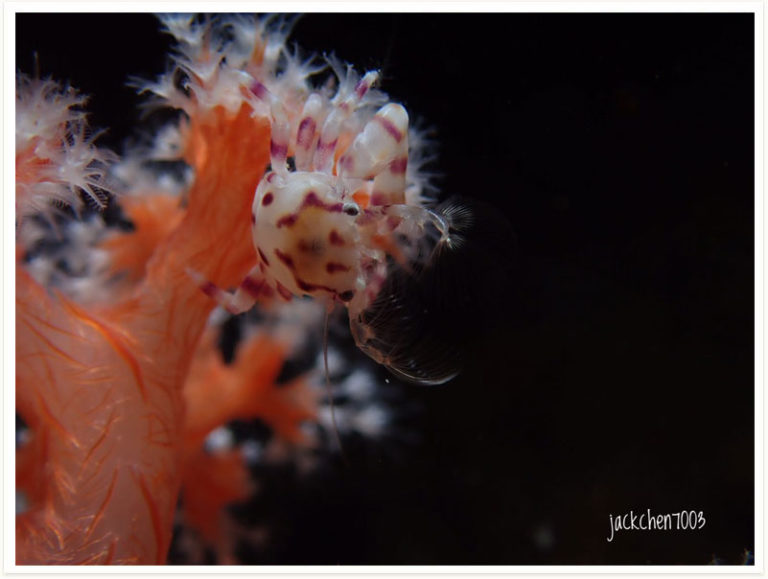
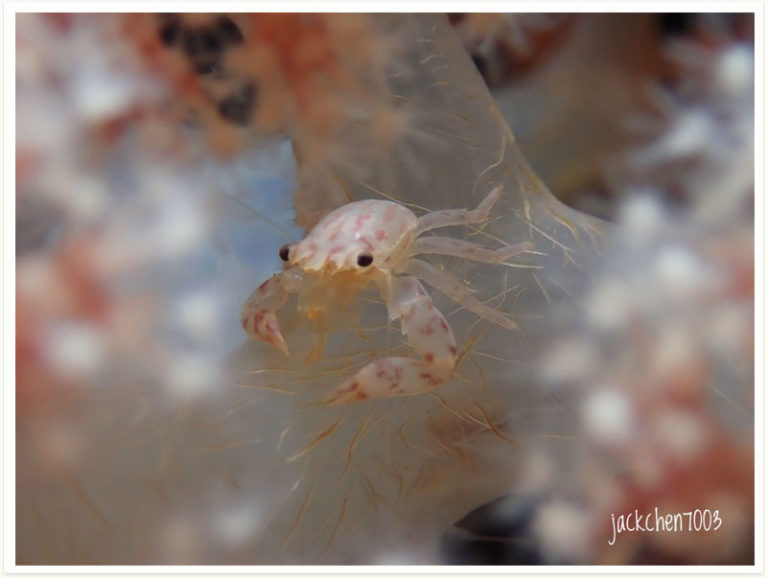
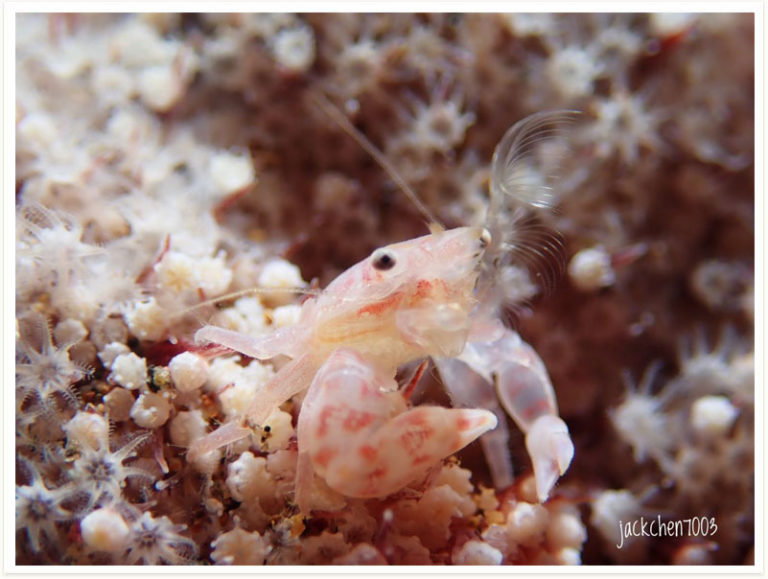 .jpg)
.jpg)
Tubastraea faulkneri is an encrusting coral that can become massive and strongly convex. The corallites of this species are covered with a porous tissue (coenosteum) with a vermicular appearance.
The calices have a diameter of 8–10 mm (0.31–0.39 in) and a depth of 5–8 mm (0.20–0.31 in). They are spaced of 5–15 mm (0.20–0.59 in) and rise of 3–8 mm (0.12–0.31 in) above the coenosteum. The tentacles of the polyps are bright yellow-orange, while the coenosteum and the center of the polyps are deeper orange. The surface of the coenosteum is swollen between calices.
Sun corals belong to a group of corals known as large-polyp stony corals. This means[clarification needed] that while they produce a hard skeleton, they do not build reefs. Different species have polyps in a variety of colors, including yellow, orange, and shades of black.
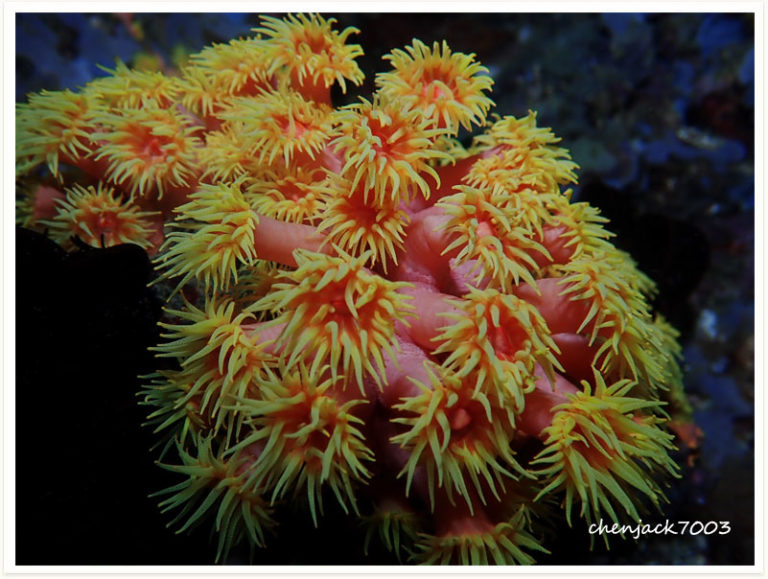
Small delicate prickly ball about 1-2cm in diameter, on a short conical stem (called the capitate structure). The ball has fine sheets between the prickles. Seen singly but sometimes a few seen near one another growing on coral rubble. This puffy fluff is just a tiny part of the sponge. The bulk of the sponge is actually buried! The main sponge is bulbous and spherical. Colour usually a deep maroon to bright pink.